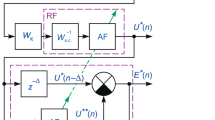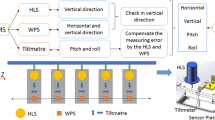Abstract
Results of numerical and experimental studies on monitoring and control for optical elements of an electric discharge KrF laser by the method of density-based spatial clustering of applications with noises (DBSCAN) are presented. Different methods of processing digital signals obtained using a position-sensitive detector controlling the position of the optical axis of the laser system are considered. A numerical model of optical system stability is developed based on the DBSCAN method with an additional inclusion of digital signal processing with the use of the cumulative moving average. A technique for correction of controlled mirrors with an accuracy of 60 ± 10 µrad for their return to normal position is proposed and implemented; the alignment time does not exceed 5 min.




Similar content being viewed by others
REFERENCES
R. A. Zacharias, N. R. Beer, E. S. Bliss, S. C. Burkhart, S. J. Cohen, S. B. Sutton, R. L. van Atta, S. E. Wintwrs, J. T. Salmon, M. R. Latta, C. J. Stolz, D. C. Pigg, and T. J. Arnold, “Alignment and wavefront control systems of the national ignition facility,” Opt. Eng. 43 (12), 2873–2884 (2004).
L. Hilsz, S. Challois, F. Nicaise, M. Luttmann, and A. Adolf, “Redesign of the image processing techniques used for the alignment of the LMJ amplifier section,” Proc. SPIE—Int. Soc. Opt. Eng. 7797, 77970 (2010).
M. V. Andreev, S. M. Bobrovnikov, E. V. Gorlov, Yu. N. Panchenko, A. V. Puchikin, and V. I. Zharkov, “Numerical method of cavity adjustment by the output beam image,” Atmos. Ocean. Opt. 31 (2), 151–155 (2018).
H. Nosato, N. Murata, T. Furuya, and M. Murakawa, “Automatic adjustment for laser systems using a stochastic binary search algorithm to cope with noisy sensing data,” Int. J. Smart Sens. Intell. Syst. 1 (2), 512–533 (2008).
V. S. Bukreev, S. K. Vartapetov, I. A. Veselovskii, A. S. Galustov, Yu. M. Kovalev, A. M. Prokhorov, E. S. Svetogorov, S. S. Khmelevtsov, and Ch. H. Li, “Excimer-laser-based lidar system for stratospheric and tropospheric ozone measurements,” Quantum Electron. 24 (6), 546-551 (1994).
Yu. N. Panchenko, M. V. Andreev, S. M. Bobrovnikov, E. V. Gorlov, V. V. Dudarev, N. G. Ivanov, V. F. Losev, A. V. Pavlinskii, A. V. Puchikin, and V. I. Zharkov, “Narrow-band tunable laser system for a lidar facility,” Russ. Phys. J. 55 (6), 609–615 (2012).
A. S. Boreisho, V. A. Volodenko, N. A. Gryaznov, E. R. Malamed, Yu. N. Mendov, V. L. Moshkov, S. M. Pantaleev, A. V. Pankratiev, A. E. Finagin, S. Ya. Chakchir, L. Yu. Frolov-Bagreev, and M. A. Konyaev, “Mobile lidar complex for ecological monitoring of the atmosphere,” Proc. SPIE—Int. Soc. Opt. Eng. 5479, 176–186 (2004).
Yu. N. Panchenko, A. V. Puchikin, S. A. Yampolskaya, S. M. Bobrovnikov, E. V. Gorlov, and V. I. Zharkov, “Narrowband KrF laser for lidar systems,” IEEE J. Quantum Electron. 57 (2), 1–5 (2021).
M. Ester, H.-P. Kriegel, J. Sander, and X. Xu, “A density-based algorithm for discovering clusters in large spatial databases with noise,” in Proc. of the II International Conference on Knowledge Discovery and Data Mining KDD-96 (1996), p. 226–231.
V. P. Borovikov and I. P. Borovikov, Statistical Analysis and Data Processing in Windows (Filin, Moscow, 1998) [in Russian].
M. G. Kendall and A. Stuart, The Advanced Theory of Statistics, Vol. 3, Design and Analysis, and Time-Series (Charles Griffin & Co., London; High Wycombe, 1976).
M. Debnath, P. K. Tripathi, and R. Elmasri, “K-DBSCAN: Identifying spatial clusters with differing density levels,” in Proc. of the International Workshop on Data Mining with Industrial Application (DMIA) (2015), p. 51–60.
Funding
This work was supported by the Russian Foundation for Basic Research (project nos. 20-08-00371-a and 20-58-00008 Bel_a) and within the framework of the state contract for Fundamental Scientific Research, Siberian Branch, Russian Academy of Sciences (no. FWRM-2021-0014).
Author information
Authors and Affiliations
Corresponding authors
Ethics declarations
The authors declare that they have no conflicts of interest.
Rights and permissions
About this article
Cite this article
Hongda Li, Andreev, M.V., Panchenko, Y.N. et al. Improving the Stability of the Optical System of a Laser Source Based on a Position-Sensitive Detector. Atmos Ocean Opt 35, 615–619 (2022). https://doi.org/10.1134/S1024856022050128
Received:
Revised:
Accepted:
Published:
Issue Date:
DOI: https://doi.org/10.1134/S1024856022050128




